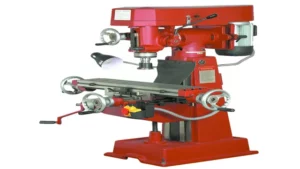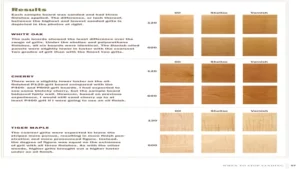If you’re in the market for a high-quality wood for your next project, you may have heard of both mahogany and sapele. These two woods are often compared due to their similarities, but there are some key differences that set them apart. In this blog post, we’ll explore the differences between mahogany and sapele, so you can make an informed decision about which wood is right for your project.
So grab a cup of coffee and let’s dive in!
Mahogany
Mahogany and sapele are two popular woods used for furniture, cabinets, and decorative features. While they share many similarities, there are a few key differences worth noting. Mahogany is a reddish-brown hardwood that is native to South and Central America.
It’s known for its durability, density, and resistance to rot. In contrast, sapele is a darker, reddish-brown wood that comes from Africa. It’s often used as a cheaper alternative to mahogany since it has similar coloring and grain patterns.
Sapele is also denser and harder than mahogany, making it more resistant to dents and scratches. However, mahogany has a more distinctive and attractive grain pattern compared to sapele. In terms of cost, mahogany is generally more expensive due to its rarity and prestige.
Ultimately, both woods are great options for high-quality furniture and decorative features, and the decision between mahogany and sapele comes down to personal preference and budget.
Color and Grain
Mahogany is a beautiful wood known for its deep reddish-brown color and fine grain. Its color can vary from light pinkish tones to dark reddish-brown hues with occasional dark brown streaks. This wood’s unique colors make it a popular choice for furniture and decorative pieces.
The wood’s grain is straight and uniform, making it ideal for carving and detailing work that requires precision and intricate patterns. Mahogany is also appreciated for its durability and resistance to decay, rot, and insect attacks. It is a dense and heavy hardwood, which gives it a rich and luxurious feel when crafted into furniture pieces.
This wood has a distinctively refined look that elevates any style of furniture or decor, from traditional to modern designs. Choosing Mahogany wood is an excellent choice for people who value beauty, quality, and durability in their furniture and decorative pieces while adding a touch of elegance to their homes.

Durability and Workability
Mahogany is a highly sought-after wood type that has been used for centuries in the making of fine furniture, musical instruments, and cabinetry. One of the reasons why mahogany is so popular among woodworkers is its durability and workability. Mahogany is known for its exceptionally dense and hard structure, which makes it resistant to scratches, dents, and impact, making it an ideal material for high-traffic furniture items.
Moreover, it is easy to cut, shape, and drill, which makes it the perfect choice for intricate designs and fine details. The natural reddish-brown color of mahogany also gives it a rich and elegant look, making it a favorite among furniture collectors and enthusiasts. However, as with any type of wood, the quality of mahogany can vary depending on the source and the manufacturing process.
It is important to purchase mahogany from a reputable supplier to ensure the highest quality and to maintain the wood’s beauty and integrity.
Common Uses
Mahogany wood is highly sought after and valued for its aesthetic appeal and durability. It is commonly used in the furniture-making industry for crafting elegant and stylish pieces. Mahogany wood is known for its beautiful reddish-brown color, which becomes even richer and more lustrous as it ages.
The wood is also popular among instrument makers and is used in the construction of guitars, pianos, and other musical instruments because of its excellent sound properties. Additionally, mahogany wood is often used in boat building due to its resistance to decay and insects and its ability to withstand harsh marine environments. Because of its versatility and numerous desirable qualities, mahogany wood is a popular choice for a variety of applications.
Sapele
If you’re a woodworking enthusiast, you may be wondering what the difference is between mahogany and sapele. While both types of wood have a beautiful grain pattern and are commonly used in high-end furniture, there are some differences between the two. Firstly, mahogany is a reddish-brown wood that comes from South America, Africa, and Central America.
Sapele, on the other hand, is often mistaken for mahogany because of its similar appearance, but it comes from West Africa and has a more golden-brown hue. In terms of hardness, sapele is harder than mahogany, which makes it a bit more durable. Sapele is also much more resistant to decay and rot, which makes it a popular choice for outdoor furniture.
Both types of wood are beautiful and versatile, so it ultimately comes down to personal preference when choosing which one to use.
Color and Grain
When it comes to wood, color and grain are two of the most important factors to consider. Sapele is a type of wood that is known for its rich color and beautiful grain patterns. Its color ranges from reddish-brown to dark brown, and it has a medium to coarse texture with an interlocking grain.
Sapele is similar in appearance to mahogany, which is why it is often used as a substitute for it, but it is more affordable. One of the unique characteristics of sapele is its chatoyance, which is a visual effect that creates a shimmering appearance when light hits the wood at different angles. The grain patterns of sapele are also highly sought after, with many woodworkers using it for decorative elements in furniture and cabinetry.
Overall, sapele is a beautiful and versatile wood that is highly valued for its color and grain.
Durability and Workability
Sapele is a highly durable and workable wood that is often used in the construction of high-end furniture, cabinetry, and musical instruments. As a member of the mahogany family, sapele is known for its deep, rich color, and interesting grain patterns, making it a popular choice among designers and craftspeople. Its durability comes from its dense and heavy structure, which makes it resistant to both rot and insect damage.
In terms of workability, sapele is fairly easy to machine, glue, and sand. This allows for intricate designs and details to be easily added. Additionally, sapele takes stain and finishes well, allowing for a wide range of color options.
So, if you’re looking for a wood that will look beautiful and last a long time, sapele is definitely worth considering.
Common Uses
Sapele is a versatile wood species that can be found in a wide variety of projects. Its mahogany-like appearance and durability make it a popular choice for cabinetry, flooring, trim, and furniture. Sapele is also used in the construction industry for exterior doors, window frames, and siding due to its resistance to decay and rot.
Its dark reddish-brown color gives a warm, inviting feel to any space it’s used in. The unique grain patterns found in Sapele can be highlighted with a clear or semi-transparent finish, creating a striking visual effect. With its durability, visual appeal, and versatility, it’s no wonder that Sapele is a go-to choice for both homeowners and professionals in different industries.
So whether you’re considering a renovation or a new construction project – Sapele might just be the perfect wood species for you.
Comparing Mahogany and Sapele
Many people often mistake mahogany and sapele for the same type of wood, but they are quite different. Mahogany has a vibrant reddish-brown color and originates from Central and South America, while Sapele has a darker reddish-brown hue with some purple undertones and is from West Africa. Mahogany is generally denser and heavier than Sapele, making it more durable and desirable for creating high-end furniture.
Sapele, on the other hand, is more affordable and is often used for musical instruments, door frames, and decorative veneers. The grain patterns of Mahogany and Sapele also differ with the former having a straighter grain while the latter has a more interlocked pattern. Although both woods have similar properties, the distinguishing features make them unique and sought after by many woodworkers and artisans.
Price
When it comes to choosing between mahogany and sapele wood, the price is an important factor to consider. Overall, sapele is generally more expensive than mahogany due to its limited availability and increasing demand. Sapele is a tropical hardwood that comes from West Africa and is highly prized for its durability, attractive grain, and rich color.
Mahogany, on the other hand, is more widely available and easier to obtain, making it a more affordable option. However, both types of wood can vary in price depending on the quality and grading, making it essential to compare prices carefully. While sapele may be more expensive, it may be worth the investment for its unique aesthetic qualities and durability.
Ultimately, it’s important to consider your budget and project needs when deciding which type of wood to use.
Sustainability
When it comes to sustainability, it’s essential to know where the wood you’re using for your furniture comes from. Mahogany and Sapele are two types of wood commonly used for furniture, but they differ in terms of sustainability. Sapele is typically harvested from sustainable forests in West Africa, whereas Mahogany is often taken from Central and South American countries where illegal logging practices are common.
This means that Sapele is a more environmentally-friendly option because it comes from responsibly managed forests. Sapele also has a high resistance to rot and insects, making it a durable choice for furniture. On the other hand, Mahogany is prized for its beauty and durability, but it’s important to make sure it’s sourced from a responsible and legal source.
Overall, when it comes to sustainability, Sapele is the better choice between the two.
Final Thoughts
In conclusion, understanding the difference between mahogany and sapele can greatly impact your woodworking project’s outcome. While both woods offer a beautiful aesthetic and are durable, there are noticeable differences in their color, texture, and strength. Mahogany has a more reddish-brown hue and is generally smoother to the touch, while sapele is darker with an intricate grain pattern.
Additionally, sapele is denser and harder, making it a great choice for flooring or other high-traffic uses. On the other hand, mahogany is softer and more lightweight, making it ideal for decorative pieces or musical instruments. Overall, it is essential to consider each wood’s unique qualities and choose the one that best suits your project’s needs.
So, whether you decide to use mahogany or sapele, both offer a rich and natural beauty that will elevate any woodworking project.
Conclusion
In the battle of mahogany vs. sapele, it all comes down to personal preference and project requirements. While mahogany may have a longer history and a recognizable name, sapele offers a unique and beautiful grain pattern at a more affordable price point.
Whether you’re building furniture or instruments, both woods have their own distinct advantages and will undoubtedly bring warmth and beauty to any project. So the next time someone asks you to choose between mahogany and sapele, just remember that the real winner is the end result – a stunning and timeless piece that will be cherished for years to come.”
FAQs
What is Mahogany?
Mahogany is a type of tropical hardwood that is known for its reddish-brown color, durability, and ability to resist decay.
What is Sapele?
Sapele is also a type of tropical hardwood that is similar in appearance to mahogany, but with a slightly darker color. It is known for its strength and stability.
What are the differences between Mahogany and Sapele?
The main differences between Mahogany and Sapele are their color and grain patterns. Mahogany has a reddish-brown color and typically has a straight-grain pattern, while Sapele has a darker color and often has a more pronounced stripe-like grain pattern.
Which wood is more expensive, Mahogany or Sapele?
Mahogany is generally more expensive than Sapele, as it is a rarer and more highly sought-after wood.
Are Mahogany and Sapele interchangeable in woodworking projects?
Yes, Mahogany and Sapele can be used interchangeably in woodworking projects, as they are both strong and durable types of wood with similar properties.
Which wood is more commonly used in furniture-making, Mahogany or Sapele?
Mahogany is more commonly used in furniture-making, as it has been a popular choice for centuries due to its beauty, durability, and workability.
Are Mahogany and Sapele sustainably sourced?
Both Mahogany and Sapele can be sustainably sourced, but it is important to make sure that they are obtained from responsible and environmentally-friendly sources.







